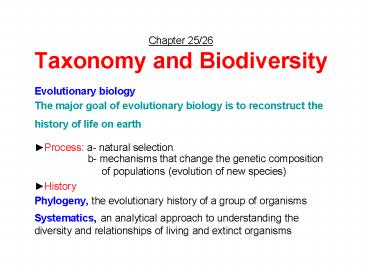Chapter 25/26 Taxonomy and Biodiversity - PowerPoint PPT Presentation
1 / 14
Title:
Chapter 25/26 Taxonomy and Biodiversity
Description:
The Molecular Data and the evolutionary relationships of life's diverse forms ... A- Molecular Data led to: a- Cladistic analysis to taxonomy, b- Cladograms ... – PowerPoint PPT presentation
Number of Views:433
Avg rating:3.0/5.0
Title: Chapter 25/26 Taxonomy and Biodiversity
1
Chapter 25/26Taxonomy and Biodiversity
- Evolutionary biology
- The major goal of evolutionary biology is to
reconstruct the history of life on earth - ?Process a- natural selection
- b- mechanisms that change the
genetic composition - of populations (evolution
of new species) - ?History
- Phylogeny, the evolutionary history of a group of
organisms - Systematics, an analytical approach to
understanding the diversity and relationships of
living and extinct organisms
2
Phylogenetic Systematics Connecting
Classification with Evolutionary History
- Carolus Linnaeus (1748) published Systema
naturae - - classification of all plants and animals known
at the time, Binomial naming of living organisms
(Genus name and Species name) - Taxonomy is an ordered division of organisms into
categories based - on similarities and
differences - Linneauss classification based on resemblances
between organisms - (not
based on evolutionary relationships) - Taxonomy employs a hierarchical system of
classification- - Domain
- Kingdom
- Phylum
- Class
- Order
- Family
- Genus
-
Species
3
Linnaeus in his Systema naturae
- What is SPECIES
- Species is a largest group of organisms that have
common similar phenotype but they have to be
capable to sexually reproduces (i.e. to combine
their genetic material) and produce fertile
progeny. - A- Each species has a two-part name,
binomial - Genus, is the closest group to which a
species belongs - Species (specific epithet, meaning
nickname or description - refers to a one
species within each genus ) - B- Species are organized hierarchically
into - broader and broader groups of
organisms - Note The first letter of the genus is
capitalized and both names are italicized and
Latinized - Example, Humans (WE men and women) are
named - Homo sapiens, The wise man.
4
Hierarchical Classification
- Means grouping species into increasingly broad
taxonomic categories - Species that appear to be closely related are
grouped into the same genus - Genera are grouped into progressively broader
categories - Family, Order, Class, Phylum, Kingdom, and
Domain (or Superkingdom) - Taxon Taxonomic unit at any level
- Example Panthera is a taxon at the genus level,
- Mammalia is a taxon at the class
level - (Mammalia includes all of the
many orders of mammals)
5
(No Transcript)
6
- Note Higher classification levels (Genus and
above) are not defined by some measurable
characteristic. ( remember Biological Species
are separated by the reproductive isolation) - The larger categories are not comparable between
lineages (ancestries). - An order of snails does not necessarily exhibit
the same degree of morphological or genetic
diversity as an order of mammals
7
New information and understanding of the tree of
life
- The Molecular Data and the evolutionary
relationships of lifes diverse forms - The first taxonomic schemes a- plant kingdom
- b-
animal kingdom - Whittaker R. H.(1969), Five-kingdom system
- Monera
- Protista
- Plantae
- Fungi
- Animalia
- Basically Two fundamentally different types of
cells - Prokaryotic (the kingdom
Monera) - Eukaryotic (the other four
kingdoms)
8
(No Transcript)
9
- kingdoms Plantae, Fungi and Animalia
(multicellular eukaryotes) distinguished by
nutrition - Plants are autotrophic, making organic food by
photosynthesis - Most fungi are decomposers with extracellular
digestion and absorptive nutrition. - Most animals ingest food and digest it within
specialized cavities - Protista includes all eukaryotes that did not fit
the definition of plants, fungi, or animals. - Most protists are unicellular. But some are
multicellular organisms (Seaweeds, because of
their relationships to specific unicellular
protists) - Note The five-kingdom system prevailed in
biology for more than 20 years - But it was challenged by-
- A- Molecular Data led to a- Cladistic
analysis to taxonomy, - b-
Cladograms - B- Systematists sorting out Protista based on
their phylogeny - into five or more new kingdoms or assigned
into the Plantae, Fungi, or Animalia
10
- Cladistic- Cladistic meaning the study of
resemblances among a clade. - Clade- Clade is a group of species that includes
an ancestral species and all its descendents. - Cladogram- Cladogram is a diagram which
represents patterns of shared characteristics - The Molecular data led to-
- Three-domain system as Superkingdoms.
- Bacteria,
- Archaea,
- Eukarya
- Bacteria differ from Archaea in many key
structural, biochemical, and physiological
characteristics. - Many microbiologists divided Bacteria and Archea
into multiple kingdoms based on cladistic
analysis of molecular data
11
(No Transcript)
12
- Taxonomy always is a work in progress
- Much more research is needed for-
- How the three domains of life are
- related?
- How many kingdoms should be included
- in each domain?
- Note New data, including the discovery of new
groups, will lead to further taxonomic
remodeling. - Keep in mind-
- Phylogenetic trees
- Taxonomic groupings
- Both are hypotheses that fit the best available
data
13
(No Transcript)
14
(No Transcript)































